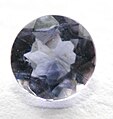Cordierite
| Cordierite | ||
|---|---|---|
Specific gravity 2.57–2.66 | | |
| Optical properties | Usually optically (-), sometimes (+); 2V = 0–90° | |
| Refractive index | nα = 1.527 – 1.560 nβ = 1.532 – 1.574 nγ = 1.538 – 1.578 Indices increase with Fe content. | |
| Pleochroism | X = pale yellow, green; Y = violet, blue-violet; Z = pale blue | |
| Fusibility | on thin edges | |
| Diagnostic features | Resembles quartz, can be distinguished by pleochroism. Can be distinguished from corundum by its lower hardness | |
| References | [2][3][4][5] | |
Cordierite (
Name and discovery
Cordierite, which was discovered in 1813, in specimens from
Occurrence
Cordierite typically occurs in contact or regional
Commercial use
Catalytic converters are commonly made from ceramics containing a large proportion of synthetic cordierite. The manufacturing process deliberately aligns the cordierite crystals to make use of the very low thermal expansion along one axis. This prevents thermal shock cracking from taking place when the catalytic converter is used.[7]
Gem variety
As the transparent variety iolite, it is often used as a gemstone. The name "iolite" comes from the Greek word for violet. Another old name is dichroite, a Greek word meaning "two-colored rock", a reference to cordierite's strong pleochroism. It has also been called "water-sapphire" and "Vikings' Compass" because of its usefulness in determining the direction of the sun on overcast days, the Vikings having used it for this purpose.[8] This works by determining the direction of polarization of the sky overhead. Light scattered by air molecules is polarized, and the direction of the polarization is at right angles to a line to the sun, even when the sun's disk itself is obscured by dense fog or lies just below the horizon.[9]
Gem quality iolite varies in color from sapphire blue to blue violet to yellowish gray to light blue as the light angle changes. Iolite is sometimes used as an inexpensive substitute for sapphire. It is much softer than sapphires and is abundantly found in Australia (Northern Territory), Brazil, Burma, Canada (Yellowknife area of the Northwest Territories), India, Madagascar, Namibia, Sri Lanka, Tanzania and the United States (Connecticut). The largest iolite crystal found weighed more than 24,000 carats (4,800 g), and was discovered in Wyoming, US.[10]
-
Left: rough specimen showing dichroism; right: cut stone
-
Facet cut iolite gemstone
-
Pleochroism of cordierite
Another name for blue iolite is steinheilite, after Fabian Steinheil, the Russian military governor of Finland who observed that it was a different mineral from quartz.[11] Praseolite is another iolite variety which results from heat treatment. It should not be confused with prasiolite.[12]
See also
References
- S2CID 235729616.
- ^ "Cordierite" (PDF). Handbook of Mineralogy. RRUFF™ Project.
- ^ a b c "Cordierite". Mindat.org.
- ^ a b http://webmineral.com/data/Cordierite.shtml Webmineral data
- ^ ISBN 0-471-80580-7.
- ISBN 0-471-25177-1.
- ISBN 978-0-8247-2343-9.
- ISBN 978-0-262-01452-6.
Many insects and a few birds perceive polarized light. The Vikings used cordierite for this purpose, a stone that allowed them to reckon the position of the sun by observing the stone's changes in color.
- ^ Noel, Oscar; Bowling, Sue Ann (March 21, 1988). "Polar Navigation and the Sky Compass". Alaska Science Forum. Geophysical Institute, University of Alaska Fairbanks. Archived from the original on April 27, 2012. Retrieved March 25, 2009.
- ^ Topix Local News: Casper, WY, Wyoming is Most Gemstone-Rich State in US, Sept. 13, 2011
- ^ Sowerby, James (1811), Exotic mineralogy: or, Coloured figures of foreign minerals: as a supplement to British mineralogy, B. Meredith, p. 173.
- ^ "Prasiolite". Amethyst Galleries' Mineral Gallery.



